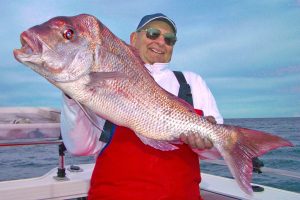
One of the 50 odd big snapper (estimated weight10 kg), that Geoff Howard and I caught (on the whiting head rigs, illustrated) and released from Shark Bay West WA, a supposedly endangered fishery on our visit in August 2000.
Just prior making our trip, the WA government declared the snapper fishery here to be endangered – that being far from the truth as we were to discover – and put a ban on the taking of snapper from this water, hence our use of circle hooks to more easily facilitate catch and release from this, the most prolific snapper fishery I have ever been involved with.
Fortunately, the flawed belief that this was an endangered fishery, which was based on the collection and counting of snapper eggs – a clearly indirect method, which does not take into account the obvious abundance of the fish being caught – gathered with double-bongo plankton nets by scientists, has since been realized and that ban has now been lifted.
Recreational fishermen may now take daily, two snapper – each with a minimum size of 50 cm – from Shark Bay West.
Fish Head Rig
The heads of small fish like those of the whiting we used in Shark Bay, mullet, and most other species of suitable size, make great baits for snapper. They survive attacks by crabs, small fish and even sea lice better than flesh baits and pilchards, and big snapper love them.
This highly effective baiting technique, that is far more effective than just impaling the fish head on a hook, employs a circle hook, to which is attached a 20 cm length of hat elastic. Or, as I have done in more recent times, used a size 35 rubber band, cut to form a single elastic strand.

- About 20 centimetres or so of hat, or other suitable elastic, is looped over the circle hook as shown, then pulled up tight.

2.A length of 0.7-or 0.8-mm galvanised tie-wire is folded over, twisted together – I used an electric drill with an Allen key in the chuck for that purpose – and cut it off at 70 mm for use as a baiting needle.

3.The baiting needle is pushed loop first through the eye tunnel of the baitfish’s head.

4.One end of your elastic is then passed through the loop in the baiting needle.

5.The needle is then withdrawn pulling the elastic through.

6.Now, push the baiting needle through the eye-tunnel of the baitfish’s head in the opposite direction and thread it with the other end of the elastic.

7.Pull that end through as well so that you now have two protruding ends.

8.Tie those two strands together under the baitfish’s head with a granny knot and pull it up firmly.

9.Your finished bait should look something like this.

10.The hooking efficacy of this bait is easily demonstrated by pulling on the leader so that the hook moves clear of, but still attached to the bait.
